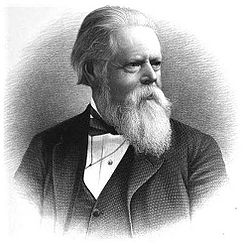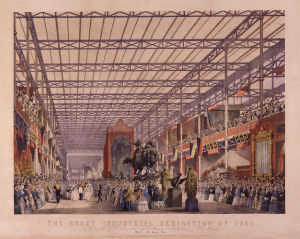Alfred Charles Hobbs: Difference between revisions
m (Protected "Alfred Charles Hobbs": Excessive vandalism: What is with you retard bots and this page?? ([edit=autoconfirmed] (indefinite) [move=autoconfirmed] (indefinite))) |
No edit summary |
||
| (3 intermediate revisions by 2 users not shown) | |||
| Line 1: | Line 1: | ||
= Alfred Charles Hobbs = | = Alfred Charles Hobbs = | ||
'''Alfred Charles Hobbs''' (1812 – 1891) was an American [[Locksmithing|locksmith]] and inventor. His most notable achievment was picking the Bramah and Chubb locks at the Great Exhibition of 1851. His ability to pick these locks changed how the world viewed the security of locks and safes, leading to the many improvements in the construction and design of locks throughout the 19th and 20th century. Hobbs also made many improvements in the field of ammunition manufacturing later in his life. | [[File:Alfred_Charles_Hobbs.jpg|thumb|250px|right|text-top|Alfred Charles Hobbs (1886)]] | ||
'''Alfred Charles Hobbs''' (1812 – 1891) was an American [[Locksmithing|locksmith]] and inventor. His most notable achievment was picking the [[Bramah]] and Chubb locks at the Great Exhibition of 1851. His ability to pick these locks changed how the world viewed the security of locks and safes, leading to the many improvements in the construction and design of locks throughout the 19th and 20th century. Hobbs also made many improvements in the field of ammunition manufacturing later in his life. | |||
__TOC__ | __TOC__ | ||
<br clear=all> | |||
== Life == | == Life == | ||
| Line 18: | Line 21: | ||
In 1851, Hobbs was sent to London's "Great Exhibition of 1851" to advertise the Parautopic Lock on behalf of New York lock maker Day & Newell. | In 1851, Hobbs was sent to London's "Great Exhibition of 1851" to advertise the Parautopic Lock on behalf of New York lock maker Day & Newell. | ||
Hobbs claimed that he could easily defeat the best lock at the time, one made by the Bramah company. Bramah accepted his challenge. Hobbs was given a sample lock, a collection of blank keys, and thirty days to pick the lock. After 24 days, in front of both judges and spectators, Hobbs opened the Bramah lock with a key he had made. When challenged as a fluke by judges, Hobbs proceeded to lock, unlock, and relock the Bramah with the same key. The manufacturer was upset; until then the lock was thought impenetrable. They claimed Hobbs had used a trick, just got lucky, or that the lock was damaged in some way. | Hobbs claimed that he could easily defeat the best lock at the time, one made by the [[Bramah]] company. Bramah accepted his challenge. Hobbs was given a sample lock, a collection of blank keys, and thirty days to pick the lock. After 24 days, in front of both judges and spectators, Hobbs opened the Bramah lock with a key he had made. When challenged as a fluke by judges, Hobbs proceeded to lock, unlock, and relock the Bramah with the same key. The manufacturer was upset; until then the lock was thought impenetrable. They claimed Hobbs had used a trick, just got lucky, or that the lock was damaged in some way. | ||
<blockquote> | <blockquote> | ||
"''The lock controversy continues a subject of great interest at the Crystal Palace, and, indeed, is now become of general importance. We believed before the Exhibition opened that we had the best locks in the world, and among us Bramah and Chubb were reckoned quite as impregnable as Gibraltar— more so, indeed, for the key to the Mediterranean was taken by us, but none among us could penetrate into the locks and shoot the bolts of these masters. The mechanical spirit, however, is never at rest, and if it is lulled into a false state of listlessness in one branch of industry, and in one part of the world, elsewhere it springs up suddenly to admonish and reproach us with our supineness. Our descendents on the other side of the water are every now and then administering to the mother country a wholesome filial lesson upon this very text, and recently they have been "rubbing us up" with a severity which perhaps we merited for sneering at their shortcomings in the Exhibition.''" [http://www.cabinetmagazine.org/issues/22/kastner.php | "''The lock controversy continues a subject of great interest at the Crystal Palace, and, indeed, is now become of general importance. We believed before the Exhibition opened that we had the best locks in the world, and among us Bramah and Chubb were reckoned quite as impregnable as Gibraltar— more so, indeed, for the key to the Mediterranean was taken by us, but none among us could penetrate into the locks and shoot the bolts of these masters. The mechanical spirit, however, is never at rest, and if it is lulled into a false state of listlessness in one branch of industry, and in one part of the world, elsewhere it springs up suddenly to admonish and reproach us with our supineness. Our descendents on the other side of the water are every now and then administering to the mother country a wholesome filial lesson upon this very text, and recently they have been "rubbing us up" with a severity which perhaps we merited for sneering at their shortcomings in the Exhibition.''" <ref>[http://www.cabinetmagazine.org/issues/22/kastner.php National Insecurity]</ref> | ||
</blockquote> | </blockquote> | ||
| Line 56: | Line 59: | ||
* 09 May 1882 - Pat. [http://www.google.com/patents?id=I_teAAAAEBAJ 257,584] - Bullet-patching machine | * 09 May 1882 - Pat. [http://www.google.com/patents?id=I_teAAAAEBAJ 257,584] - Bullet-patching machine | ||
* 13 Mar. 1883 - Pat. [http://www.google.com/patents?id=uNw_AAAAEBAJ 273,374] - Machine for heading cartridge-shells | * 13 Mar. 1883 - Pat. [http://www.google.com/patents?id=uNw_AAAAEBAJ 273,374] - Machine for heading cartridge-shells | ||
== References == | |||
<references /> | |||
== See also == | == See also == | ||
Latest revision as of 21:01, 21 September 2011
Alfred Charles Hobbs
Alfred Charles Hobbs (1812 – 1891) was an American locksmith and inventor. His most notable achievment was picking the Bramah and Chubb locks at the Great Exhibition of 1851. His ability to pick these locks changed how the world viewed the security of locks and safes, leading to the many improvements in the construction and design of locks throughout the 19th and 20th century. Hobbs also made many improvements in the field of ammunition manufacturing later in his life.
Life
Hobbs was born in Boston, Massachusetts in 1812 to two English parents. He married and had a son, Alfred J. Hobbs.
Hobbs became one of the founders of the lock making firm Hobbs Hart & Co. Ltd. The company started in 1851 and was formally registered as Hobbs and Co. in 1852. By 1855 it was Hobbs, Ashley and Company. The name then changed to Hobbs, Ashley and Fortescue, with an address at 97 Cheapside, London. For the next ninety years the address was 76 Cheapside, London.
In 1860 Hobbs returned to America, living in Bridgeport, Connecticut. He went on to hold many patents for firearm ammunition manufacturing. Hobbs died in Bridgeport, Connecticut in the fall of 1891.
The Great Exhibition of 1851
In 1851, Hobbs was sent to London's "Great Exhibition of 1851" to advertise the Parautopic Lock on behalf of New York lock maker Day & Newell.
Hobbs claimed that he could easily defeat the best lock at the time, one made by the Bramah company. Bramah accepted his challenge. Hobbs was given a sample lock, a collection of blank keys, and thirty days to pick the lock. After 24 days, in front of both judges and spectators, Hobbs opened the Bramah lock with a key he had made. When challenged as a fluke by judges, Hobbs proceeded to lock, unlock, and relock the Bramah with the same key. The manufacturer was upset; until then the lock was thought impenetrable. They claimed Hobbs had used a trick, just got lucky, or that the lock was damaged in some way.
"The lock controversy continues a subject of great interest at the Crystal Palace, and, indeed, is now become of general importance. We believed before the Exhibition opened that we had the best locks in the world, and among us Bramah and Chubb were reckoned quite as impregnable as Gibraltar— more so, indeed, for the key to the Mediterranean was taken by us, but none among us could penetrate into the locks and shoot the bolts of these masters. The mechanical spirit, however, is never at rest, and if it is lulled into a false state of listlessness in one branch of industry, and in one part of the world, elsewhere it springs up suddenly to admonish and reproach us with our supineness. Our descendents on the other side of the water are every now and then administering to the mother country a wholesome filial lesson upon this very text, and recently they have been "rubbing us up" with a severity which perhaps we merited for sneering at their shortcomings in the Exhibition." [1]
Hobbs contribution was not only in exposing the weakness of the English locks but also in advertising his company's Parautopic lock. The parautopic was considered more secure than those he had compromised, at the time.
Literature
- Locks and Safes: The Construction of Locks. Virtue & Co., London, 1853 (revised 1868)
Patents
- 20 May 1842 - Pat. 2,628 - Manner of making glass knobs
- 04 Sep. 1849 - Pat. 6,690 - Machine for crushing ice
- 07 May, 1867 - Pat. 64,532 - Improvement in steam-engine slide-valves
- 04 Apr. 1871 - Pat. 113,431 - Improvement in bullet patches
- 26 Sep. 1871 - Pat. 119,357 - Improvement in cartridge-shells for drill purposes
- 24 Oct. 1871 - Pat. 120,196 - Improvement in primers for cartridges
- 18 Feb. 1873 - Pat. 135,913 - Improvements in catridge loading machines
- 19 Feb. 1873 - Pat. 135,913 - Improvement in cartridge-loading machines
- 15 Apr. 1873 - Pat. 137,773 - Improvements in machines for winding wads
- 28 Oct. 1873 - Pat. 143,981 - Improvements in machines for interlocking cartridge shells with bullets
- 26 Dec. 1873 - Pat. 148,366 - Improvement in primers for cartridges
- 13 Oct. 1874 - Pat. 155,835 - Improvement in annealing cartridge-shells
- 09 May 1876 - Pat. 177,066 - Improvement in machines for making cartridge-shells
- 09 May 1976 - Pat. 177,067 - Improvement in devices for punching the heads of cartridge-shells
- 19 Aug. 1879 - Pat. 218,629 - Improvements in gun-wads
- 01 June 1880 - Pat. 228,197 - Machine for drawing cartridge-shells
- 01 Feb. 1881 - Pat. 237,276 - Cartridge reinforce pasting machine
- 01 Mar. 1881 - Pat. RE9594 - Machine for drawing cartridge-shells
- 03 May 1881 - Pat. 240,826 - Machine for heading cartridge-shells
- 14 June 1881 - Pat. 242,775 - Machine for uncapping cartridge-shells
- 09 May 1882 - Pat. 257,584 - Bullet-patching machine
- 13 Mar. 1883 - Pat. 273,374 - Machine for heading cartridge-shells

